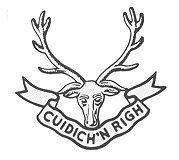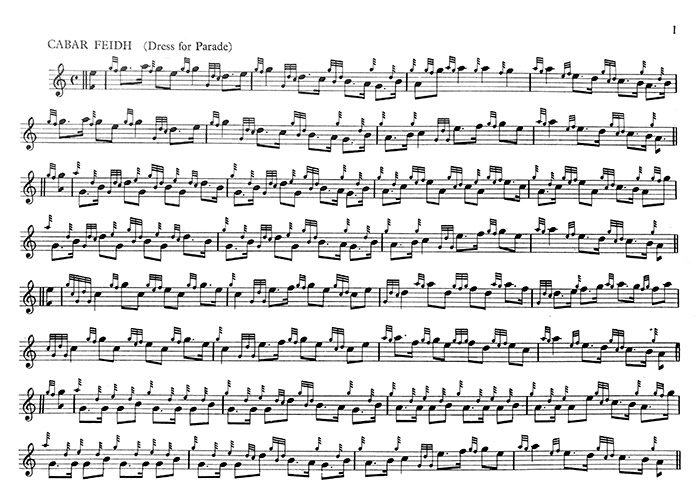
Today we have the third instalment of our abridged excerpts from the above book by Ian Hamilton Mackay Scobie. The book was published in 1924 and is now out of print. This excerpt talks of piobaireachd being superseded by ceol beag as duty tunes and the effect on the fingers of playing in bands. Above is a picture of Seaforth militia pipers in 1880 under P/M Ronald MacKenzie….
 In an old order book of the 72nd [regimental forerunner of the Seaforths] appears a List of Tunes (mostly Ross-shire and MacKenzie ones), which show the use of the bagpipes in regulating the interior workings of a Highland regiment. This list, which was probably compiled on the formation of the 72nd, and adhered to for many years, contains several piobaireachd which are now but little known.
In an old order book of the 72nd [regimental forerunner of the Seaforths] appears a List of Tunes (mostly Ross-shire and MacKenzie ones), which show the use of the bagpipes in regulating the interior workings of a Highland regiment. This list, which was probably compiled on the formation of the 72nd, and adhered to for many years, contains several piobaireachd which are now but little known.
The old time style of playing was slower than now, and with less profusion of embellishing notes (grace notes) in the tune. But regimental pipers of a century ago [1824], taken as a whole, were probably more careful players than the average modern regimental player. The mere fact of the former being used to play solo more frequently than in a band, and to his being first and foremost a piobaireachd player (which is conducive to careful fingering),,, tends to prove this.
The modern ‘playing’ piper, on the other hand, has seldom to perform solo beyond his duty tunes when orderly piper; while too much playing in a band leads to hasty, and so faulty, slip-shod fingering. The Army School of Piping in Edinburgh Castle, established in 1910, has done much towards improving the standard of playing in the Army. No piper is now made a Pipe Major unless he has passed through the school.
The list of [72nd] tunes is as follows:
Reveille – Surachan – The MacRae’s March
Gathering – Cruinneachadh – Tulloch Ard
Salute – Failte – MacKenzie’s Salute
Slow March – An Cuilfhionn – Fingal’s Weeping
Quickstep – Castle Donan
Charge – Cabar Feidh
Stimulus – during the engagement – Battle of Strome
Lament – Cumha – MacKenzie’s Lament
Sunset – MacKenzie’s March
Tattoo – Head of the High Bridge
Warning before dinner – Battle of Glenshiel
During dinner – Battle of Sherrifmuir
[wds id=”2″]
Most of the above tunes were afterwards changed for shorter or simpler airs. In time the universal Scottish reveille Hey, Johnnie Cope came to be played in the regiment as the ‘rouse’ or daybreak tune and for the first and second Meal Pipes (at breakfast, dinner and tea), Bundle and Go and Blythe and Merry was She respectively, while the old Gaelic air ‘Caidil, mo ghaol’, known as Sleep Dearie, Sleep was adopted for Lights Out. This old air…has been familiarly called, in some regiments, ‘Soldiers lie doon on yer wee pickle straw’. Blythe and Merry was She was altered for Brose and Butter as the second Meal Tune in 1911 when the duty calls of the 1st, 2nd and 3rd Battalions were made uniform.
There are old words to the former tune composed by some soldier way back in the 50s of the last century:
Hey Jock! are ye glad ye ‘listed
Hey Donal’! is yer belly fu’
Hey Jock! are ye glad ye ‘listed
How dae ye like the sodgers noo?
Highland soldiers were known in the old days as ‘Donald’, ‘Rory’ or ‘Her Nainsel’ [roughly, a Highlanders way of speaking of himself] until with the growing preponderance of lowland Scots in the ranks, the essentially lowland name ‘Jock’ took their place in the latter half of the last century.
Cabar Feidh (one of the most inspiring of Highland airs) is still used for the Dress for Parade and in reel or strathspey time for the Charge. The setting of this tune is the traditional one as handed down.

For years after the old 72nd and 78th were united in 1881 they continued to play the duty tunes peculiar to each which necessitated a piper who was transferred from one battalion to the other learning new tunes, or fresh settings of tunes. This unsatisfactory state of affairs was remedied in 1912 when a list of ‘Regimental Pipe Tunes’ (including favourite duty tunes of both battalions) was drawn up for common use……..
Although the tunes were now made uniform the question of divergency in their settings still arose and has only lately been settled. In fact it was only quite recently that ….. Cabar Feidh was made uniform in the two regular battalions. As regards the standardising of the more commonly known tunes throughout the army, the Army School of Piping has already done much towards that end. But even at present ‘the individuality as regards tunes which exist in every battalion and regiment makes it very difficult indeed to get a number of bands to play even the best known tunes together without considerable practice’ – The Pipes of War 1920.
• Read the earlier excerpts in this series here.
[wds id=”3″]
















Recent Comments